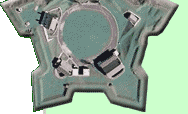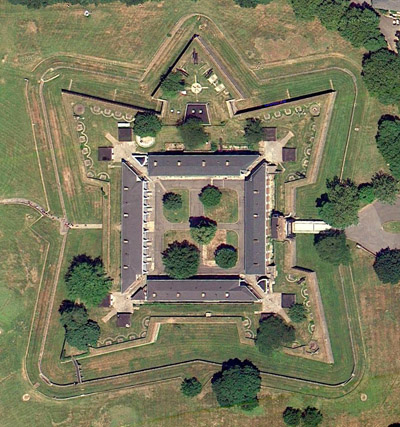
 |
 |
Fort Jay Governor's Island, New York Harbor |
 |
 |
 |
 |
 |
||
 |
The first fortification built on Governor's Island in New York Harbor was essentially a long pile of dirt, constructed by General Israel Putnam (1718-1790). This earthwork was intended to provide cover for eight cannon, so placed in April of 1776 to defend New York Harbor from the wicked British. A few more pieces of artillery were added to this effort, and on July 12 1776 the battery engaged the British Navy: The HMS Phoenix and HMS Rose were sufficiently damaged in this action as to keep them out of the East River, which would enable General George Washington (1732-1799) to withdraw from Brooklyn in August of 1776 without detection and subsequent annihilation. The HMS Rose, a 20-gun sixth-rate post ship, would go on to be heroically scuttled in the channel at Savannah, Georgia in 1779, blocking the waterway to prevent the French navy from assisting the American rebels. This expert sinkery kept Savannah in British hands until the end of the American Revolutionary War (1775-1783). American forces abandoned Governor's Island in September of 1776, and the British improved its earthworks and set up a Royal Navy hospital there. The British finally left on November 25 1783, nearly three months after the Treaty of Paris was signed, ending the war. The island's fortifications lay rotting until 1794, when the state of New York financed the construction of a proper fort, named for Governor John Jay (1745-1829), one of the US' Founding Fathers, who would go on to be the first Chief Justice of the US Supreme Court. Congress wound up spending so much money on Fort Jay's construction and upkeep that New York State sold Governor's Island and the fort to the Federal government for one dollar in 1800. The fort was rechristened Fort Columbus, for Italian explorer Christopher Columbus (1451-1506) of all people. I mean, the guy already had a city named after him in Ohio. Really now. Fort Jay represented one of the first undertakings of the Second System of US seacoast defense. By the end of the 18th century, the US government was looking to divest itself of foreign engineers, who up 'til then had been relied upon heavily for the design and construction of US fortifications. In 1802 Congress separated the army's engineer and artillery arms into two services, directing the Corps of Engineers to create a military academy at West Point, New York. The improvements made to Fort Jay leading up to the War of 1812 (1812-1814) were designed by Major Jonathan Williams (1751-1815), Chief of Engineers of the Corps of Engineers. Few actual forts came about as a result of the Second System, though it should be noted that during the War of 1812 Baltimore was successfully defended from invasion by Fort McHenry, a Second System fort, while Washington DC, which remained conspicuously fortless, was burned to the ground. During the US Civil War (1861-1865), Fort Jay was armed with nearly 50 10" and 15" Rodman Guns, a smoothbore cannon made to fire both shot and shell. These cannon remained on station until October of 1942, when all but four were scrapped for the Second World War (1939-1945) effort. The remaining four Rodman Guns still stand vigil today, protecting lower Manhattan from the Confederate Navy...successfully, might I add! Some of Fort Jay's barracks were used to hold captured Confederate officers during the Civil War, pending transfer to proper military prisons. At the beginning of the 20th century, US President Teodore Roosevelt (1858-1919)'s Secretary of War, Elihu Root (1845-1937), foiled the city of New York's plans to steamroll Governor's Island, making way for a public park. Root championed the cause of not only retaining Fort Jay as an army post, but expanding Governor's Island itself from 60 acres to 170, utilizing landfill produced by the recent construction of New York City's subway system. In one of his last acts as Secretary in 1904, Root had the name Fort Columbus officially changed back to Fort Jay. Definitely a friend to all starfort fans, that Elihu Root. In the 1920's, part of the glacis surrounding Fort Jay was used as a polo field. In the 1930's, laborers with the Works Progress Administration built a weird little nine-hole golf course next to the fort, which remained in operation until 1996 as Manhattan's only golf course. The First United States Army was activated on November 11 1933: Its second out of four corps were stationed at Fort Jay, which also served as the First Army's headquarters. During the Second World War, First Army landed at Normandy on June 6 1944, fought in the Battle of the Bulge, and found an intact bridge over the Rhine at Remagen. In 1964 the First Army moved its headquarters to Fort Meade, Maryland. The US Coast Guard assumed control of Governor's Island in 1966, using Fort Jay to house junior officers and civilian staff until closing the base in 1996. Fort Jay was named part of the Governor's Island National Monument in 2001, and since 2003 has been open to the public.  | |
 |
||
|
|
|||||||
Info Source 1
Info Source 2
Info Source 3
Info Source 4
Info Source 5 Info Source 6 Info Source 7 Info Source 8 Info Source 9 Info Source 10 Info Source 11 Info Source 12 Thanks to Google Maps for the image! ©2010 starforts.com |
 |